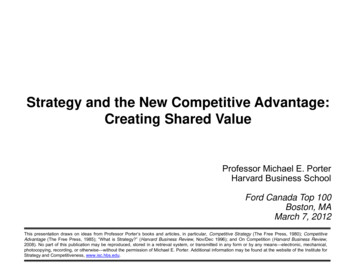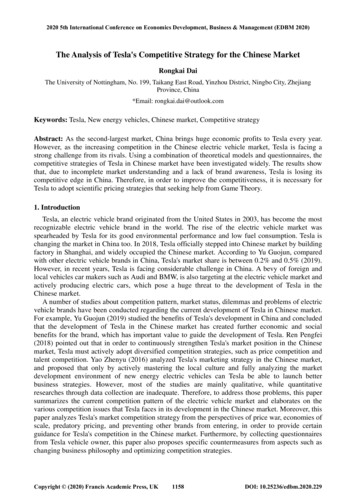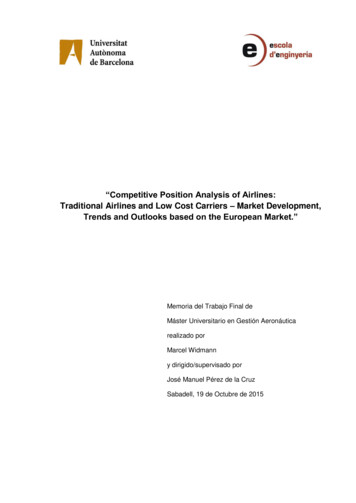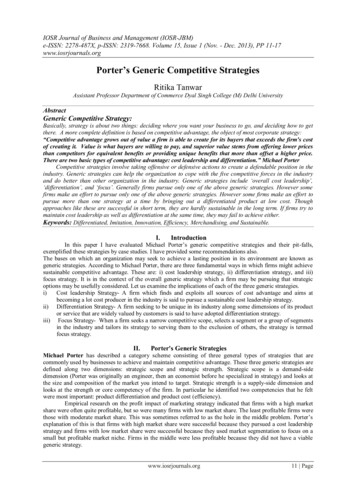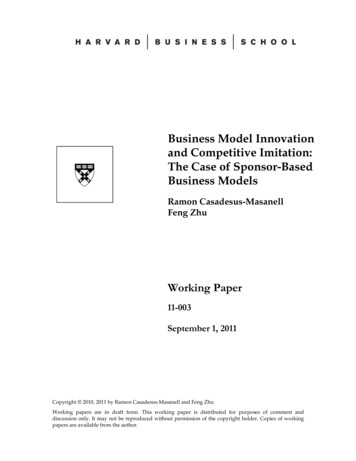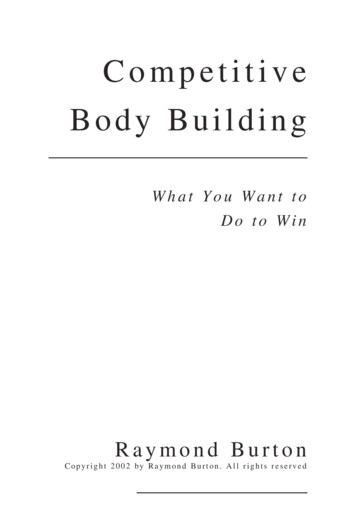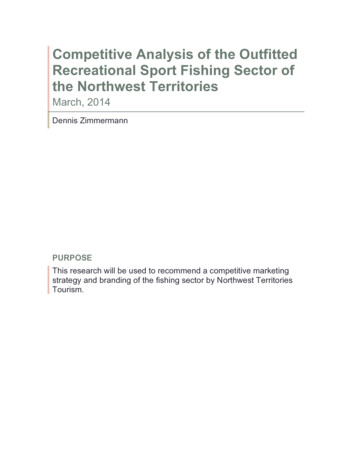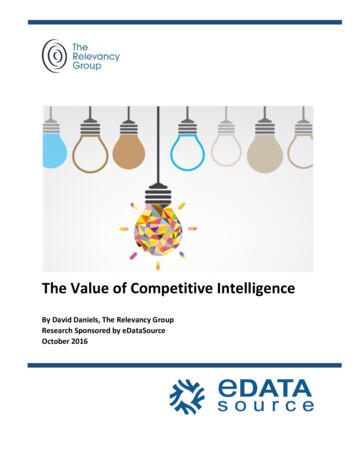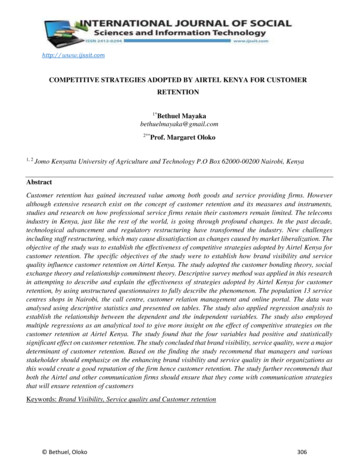![05[2] Strategy Competitors, Competitive Rivalry .](/img/2/052-strategy-competitors-competitive-rivalry-competitive-behavior-and-competitive-dynamics.jpg)
Transcription
CHAPTER 5STRATEGICACTIONS:STRATEGYFORMULATIONPowerPoint Presentation by Charlie CookThe University of West Alabama 2007 Thomson/SouthThomson/South-Western.All rights reserved.Strategy competitors, competitiverivalry, competitive behavior, andcompetitive dynamicsStrategicManagementManagementof StrategyCompetitiveness and Globalization:ConceptsSeventh editionConceptsand Cases and CasesMichael A. Hitt R. Duane Ireland Robert E. Hoskisson
KNOWLEDGE OBJECTIVESStudying this chapter should provide you with the strategicmanagement knowledge needed to:1. Define competitors, competitive rivalry, competitive behavior, andcompetitive dynamics.2. Describe market commonality and resource similarity as thebuilding blocks of a competitor analysis.3. Explain awareness, motivation, and ability as drivers of competitivebehavior.4. Discuss factors affecting the likelihood a competitor will takecompetitive actions.5. Discuss factors affecting the likelihood a competitor will respond toactions taken against it.6. Explain competitive dynamics in slow-cycle, fast-cycle, andstandard-cycle markets. 2007 Thomson/South-Western. All rights reserved.5–2
Definitions Competitors Firms operating in the same market, offering similarproducts and targeting similar customers. Competitive Rivalry The ongoing set of competitive actions and responsesoccurring between competitors. Competitive rivalry influences an individual firm’sability to gain and sustain competitive advantages. 2007 Thomson/South-Western. All rights reserved.5–3
Definitions Competitive Behavior The set of competitive actions and competitiveresponses the firm takes to build or defend itscompetitive advantages and to improve its marketposition. Multimarket Competition Firms competing against each other in severalproduct or geographic markets. Competitive Dynamics The total set of actions and responses taken by allfirms competing within a market. 2007 Thomson/South-Western. All rights reserved.5–4
From Competitors to Competitive ow? To gain an advantageousmarket position Competitive Behavior Competitive actions Competitive responsesWhat Results?What Results?Competitive DynamicsCompetitive actions and responses takenby all firms competing in a market 2007 Thomson/South-Western. All rights reserved.5–5
Figure 5.1From Competitors to Competitive DynamicsSource: Adapted from M.-J. Chen, 1996, Competitor analysis and interfirm rivalry: Towarda theoretical integration, Academy of Management Review, 21: 100–134. 2007 Thomson/South-Western. All rights reserved.5–6
Competitive Rivalry’s Effect on Strategy Success of a strategy is determined by: The firm’s initial competitive actions. How well it anticipates competitors’responses tothem. How well the firm anticipates and responds to itscompetitors’initial actions. Competitive rivalry: Affects all types of strategies. Has the strongest influence on the firm’s businesslevel strategy or strategies. 2007 Thomson/South-Western. All rights reserved.5–7
A Model of Competitive Rivalry Firms are mutually interdependent A firm’s competitive actions have noticeable effectson its competitors. A firm’s competitive actions elicit competitiveresponses from its competitors. Competitors feel each other’s actions and responses. Marketplace success is a function of bothindividual strategies and the consequences oftheir use. 2007 Thomson/South-Western. All rights reserved.5–8
A Model of Competitive RivalryCompetitive Analysis Market commonality Resource similarityFeedbackOutcomes Market position Financialperformance 2007 Thomson/South-Western. All rights reserved.Drivers of CompetitiveBehavior Awareness Motivation AbilityInterfirm Rivalry Likelihood of Attack First-mover incentives Organizational size Quality Likelihood of Response Type of competitive action Reputation Market dependence5–9
FIGURE 5.2A Model of Competitive RivalrySource: Adapted from M.-J. Chen, 1996, Competitor analysis and interfirm rivalry:Toward a theoretical integration, Academy of Management Review, 21: 100–134. 2007 Thomson/South-Western. All rights reserved.5–10
Competitor Analysis Competitor analysis is used to help a firmunderstand its competitors. The firm studies competitors’future objectives,current strategies, assumptions, and capabilities. With the analysis, a firm is better able to predictcompetitors’behaviors when forming itscompetitive actions and responses. 2007 Thomson/South-Western. All rights reserved.5–11
Market Commonality Market commonality is concerned with: The number of markets with which a firm and acompetitor are jointly involved. The degree of importance of the individual markets toeach competitor. Firms competing against one another in severalor many markets engage in multimarketcompetition. A firm with greater multimarket contact is less likely toinitiate an attack, but more likely to more respondaggressively when attacked. 2007 Thomson/South-Western. All rights reserved.5–12
Resource Similarity Resource Similarity How comparable the firm’s tangible and intangibleresources are to a competitor’s in terms of both typesand amounts. Firms with similar types and amounts ofresources are likely to: Have similar strengths and weaknesses. Use similar strategies. Assessing resource similarity can be difficult ifcritical resources are intangible rather thantangible. 2007 Thomson/South-Western. All rights reserved.5–13
FIGURE 5.3A Framework of Competitor AnalysisSource: Adapted from M.-J. Chen, 1996, Competitor analysis and interfirm rivalry:Toward a theoretical integration, Academy of Management Review, 21: 100–134. 2007 Thomson/South-Western. All rights reserved.5–14
Drivers of Competitive BehaviorAwareness Awareness is the extent to whichcompetitors recognize thedegree of their mutualinterdependence thatresults from: Market commonality Resource similarity 2007 Thomson/South-Western. All rights reserved.5–15
Drivers of Competitive Behavior (cont’d)AwarenessMotivation 2007 Thomson/South-Western. All rights reserved. Motivation concerns the firm’s incentive to takeaction or to respond to acompetitor’s attack and relates to perceivedgains and losses5–16
Drivers of Competitive Behavior (cont’d)AwarenessMotivationAbility Ability relates to each firm’s resources the flexibility theseresources provide Without availableresources the firm lacksthe ability to attack a competitor respond to the competitor’sactions 2007 Thomson/South-Western. All rights reserved.5–17
Drivers of Competitive Behavior ity 2007 Thomson/South-Western. All rights reserved. A firm is more likely to attackthe rival with whom it has lowmarket commonality than theone with whom it competes inmultiple markets. Given the strong competitionunder market commonality, it islikely that the attacked firm willrespond to its competitor’saction in an effort to protect itsposition in one or moremarkets.5–18
Drivers of Competitive Behavior ityResourceDissimilarity 2007 Thomson/South-Western. All rights reserved. The greater the resourceimbalance between the acting firmand competitors or potentialresponders, the greater will be thedelay in response by the firm with aresource disadvantage. When facing competitors withgreater resources or moreattractive market positions, firmsshould eventually respond, nomatter how challenging theresponse.5–19
Competitive Rivalry Competitive Action A strategic or tactical action the firm takes to build ordefend its competitive advantages or improve itsmarket position. Competitive Response A strategic or tactical action the firm takes to counterthe effects of a competitor’s competitive action. 2007 Thomson/South-Western. All rights reserved.5–20
Strategic and Tactical Actions Strategic Action (or Response) A market-based move that involves a significantcommitment of organizational resources and isdifficult to implement and reverse. Tactical Action (or Response) A market-based move that is taken to fine-tune astrategy: Usually involves fewer resources. Is relatively easy to implement and reverse. 2007 Thomson/South-Western. All rights reserved.5–21
Factors Affecting Likelihood of AttackFirst-MoverIncentivesFirst MoverA firm that takes aninitial competitive actionin order to build ordefend its competitiveadvantages or toimprove its marketposition. First movers allocate funds for: Product innovation anddevelopment Aggressive advertising Advanced research anddevelopment First movers can gain: The loyalty of customers who maybecome committed to the firm’sgoods or services. Market share that can be difficultfor competitors to take duringfuture competitive rivalry. 2007 Thomson/South-Western. All rights reserved.5–22
Factors Affecting Likelihood of Attack (cont’d)First MoverSecond MoverIncentives Second mover responds to the firstmover’s competitive action, typicallythrough imitation: Studies customers’reactions toproduct innovations. Tries to find any mistakes the firstmover made, and avoid them. Can avoid both the mistakes andthe huge spending of the firstmovers. May develop more efficientprocesses and technologies. 2007 Thomson/South-Western. All rights reserved.5–23
Factors Affecting Likelihood of Attack (cont’d)First MoverSecond MoverLate Mover 2007 Thomson/South-Western. All rights reserved. Late mover responds to acompetitive action only afterconsiderable time has elapsed. Any success achieved will be slowin coming and much less than thatachieved by first and secondmovers. Late mover’s competitive actionallows it to earn only averagereturns and delays itsunderstanding of how to createvalue for customers.5–24
Factors Affecting Likelihood of Attack (cont’d)First Mover Small firms are more likely: To launch competitive actions.Second Mover To be quicker in doing so. Small firms are perceived as: Nimble and flexible competitorsLate MoverOrganizationalSize- Small 2007 Thomson/South-Western. All rights reserved. Relying on speed and surprise todefend competitive advantages ordevelop new ones while engaged incompetitive rivalry. Having the flexibility needed tolaunch a greater variety ofcompetitive actions.5–25
Factors Affecting Likelihood of Attack (cont’d)First MoverSecond MoverLate MoverOrganizationalSize -Large Large firms are likely to initiatemore competitive actions as well asstrategic actions during a given timeperiod Large organizations commonlyhave the slack resources requiredto launch a larger number of totalcompetitive actions Think and act big and we’ll getsmaller. Think and act small andwe’ll get bigger.Herb KelleherFormer CEO, Southwest Airlines 2007 Thomson/South-Western. All rights reserved.5–26
Factors Affecting Likelihood of Attack (cont’d)First MoverSecond MoverLate MoverOrganizationalSizeQuality(Product) 2007 Thomson/South-Western. All rights reserved. Quality exists when the firm’sgoods or services meet orexceed customers’expectations Product quality dimensionsinclude: Performance Conformance Features Serviceability Flexibility Aesthetics Durability Perceivedquality5–27
Table 5.1Quality Dimensions of Goods and ServicesProduct Quality Dimensions1. Performance—Operating characteristics2. Features—Important special characteristics3. Flexibility—Meeting operating specifications over someperiod of time4. Durability—Amount of use before performance deteriorates5. Conformance—Match with preestablished standards6. Serviceability—Ease and speed of repair7. Aesthetics—How a product looks and feels8. Perceived quality—Subjective assessment of characteristics(product image)SOURCES: Adapted from J.W. Dean, Jr., & J. R. Evans, 1994, Total Quality: Management, Organization and Society, St.Paul, MN:West Publishing Company; H.V. Roberts & B. F. Sergesketter, 1993, Quality Is Personal, New York:The FreePress; D. Garvin, 1988, Managed Quality: The Strategic and Competitive Edge, New York:The Free Press. 2007 Thomson/South-Western. All rights reserved.5–28
Factors Affecting Likelihood of Attack (cont’d)First MoverSecond MoverLate MoverOrganizationalSizeQuality(Service) 2007 Thomson/South-Western. All rights reserved. Service quality dimensionsinclude: Timeliness Courtesy Consistency Convenience Completeness Accuracy5–29
Table 5.1Quality Dimensions of Goods and Services (cont’d)Service Quality Dimensions1. Timeliness—Performed in the promised period of time2. Courtesy—Performed cheerfully3. Consistency—Giving all customers similar experiences each time4. Convenience—Accessibility to customers5. Completeness—Fully serviced, as required6. Accuracy—Performed correctly each timeSOURCES: Adapted from J.W. Dean, Jr., & J. R. Evans, 1994, Total Quality: Management, Organization and Society, St.Paul, MN:West Publishing Company; H.V. Roberts & B. F. Sergesketter, 1993, Quality Is Personal, New York:The FreePress; D. Garvin, 1988, Managed Quality: The Strategic and Competitive Edge, New York:The Free Press. 2007 Thomson/South-Western. All rights reserved.5–30
Likelihood of Response Responses to a competitor’s action are takenwhen the action: Leads to better use of the competitor’s capabilities togain or produce stronger competitive advantages oran improvement in its market position. Damages the firm’s ability to use its capabilities tocreate or maintain an advantage. Makes the firm’s market position becomes lessdefensible. 2007 Thomson/South-Western. All rights reserved.5–31
Factors Affecting Likelihood of Response Firms study three other factors to predict how acompetitor is likely to respond to competitiveactions: Type of competitive action Reputation Market dependence 2007 Thomson/South-Western. All rights reserved.5–32
Factors Affecting Strategic ResponseType ofCompetitiveAction Strategic actions receivestrategic responses Strategic actions elici
Define competitors, competitive rivalry, competitive behavior, and competitive dynamics. 2. Describe market commonality and resource similarity as the building blocks of a competitor analysis. 3. Explain awareness, motivation, and ability as drivers of competitive behavior. 4. Discuss factors affecting the likelihood a competitor will take competitive actions. 5. Discuss factors affecting the .
